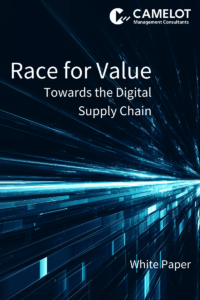“The way in which more than 99% of end-users and vendors interpret ‘demand-driven’ supply chains is dangerous, if not outright deadly, to a modern supply chain.”
(Source: Gartner Maverick Research Demand-Driven is Deadly to Your Supply Chain)
Much has been said and written about the increased, and sometimes even new challenges, supply chain management is facing and about the need to achieve resiliency (see also our blog article on Mastering Uncertainty)
The Gartner Maverick Research Demand-Driven is Deadly to Your Supply Chain not only provides insight into a critical obstacle to achieving this resiliency but also gives guidelines on how to overcome it.
CAMELOT has not only been a strong propagator of the “right” interpretation of demand-driven and has successfully consulted companies on their journey to becoming “truly” demand-driven, but also supported the underlying principles of resilient planning such as
- decoupling – allowing for embedding resiliency, reducing complexity in planning and thus enabling uncertainty-based planning
- replenishment based on actual customer demand vs. forecast and integration with demand-driven scheduling to achieve a balanced, realistic, and executable plan for each decoupled segment
as a solution provider with the Camelot LEAN Suite for many years. Our new, cloud-native Avatar solution pushes the adoption of resilient planning even further and provides the necessary unified data model and concurrent planning functions for E2E, resilient planning supporting all proven principles, alongside an integrated risk-aware planning framework.
Why did we embark on this journey early on and why do we believe that we have taken the right route?
Gartner’s view in this research provides an excellent explanation and justification blueprint.
The majority of end users and vendors, as stated by Gartner, to this date predominantly perceive and implement supply chain and operations planning on a forecast-driven principle. This means that the quality of the plan for the entire supply chain depends on high forecast accuracy. “It is deadly because it is based on the fallacy that forecasts are always inaccurate, and this fallacy effectively gets propagated throughout the supply chains and undermines corporate performance and stability.” A subsequent assumption, that with the improvement of processes and with the use of new technology such as AI and ML the forecast accuracy can be improved, proves equally fateful.
“This accuracy thinking thus becomes one of the key obstacles to achieving resilient supply chains. Its application are rigid and fragile supply chains that are unfit and unexecutable for today’s VUCA world and lead to significant performance impairment.”
(Source: Gartner Maverick Research Demand-Driven is Deadly to Your Supply Chain)
The events and disruptions of the past two years and especially in 2022 have shown, that uncertainty is and will remain a given and must be modeled in the supply chain network and integrated into planning (see White Paper “Risk-Aware Supply Chain Decision-Making”).
Having the entire supply chain plan dependent on forecast accuracy, however, does not allow for the consideration of this uncertainty. And the initiatives of end-to-end optimization of supply chains realistically prohibit any form of probabilistic (i.e. uncertainty-driven) planning due to the high complexity.
In line with Gartner’s recommendation, CAMELOT encourages companies to
- implement uncertainty-driven planning as one of the critical prerequisites to becoming resilient;
- use forecast in the very short-term and for parameterization of the, ideally, decoupled E2E supply chain;
- embed risk and thus uncertainty in the supply chain setup and incorporate it into planning. Assess the impact of uncertainty and disruptions on your performance, re-design network capabilities, and allow for re-configuration of planning parameters;
- introduce new KPIs that reflect the E2E approach and truly demand-driven principles of planning and managing the supply chain;
- introduce a strong SO&E process, in accordance with S&OP, not replacing it.
We would like to thank Frank Arnold for his valuable contribution to this article.

